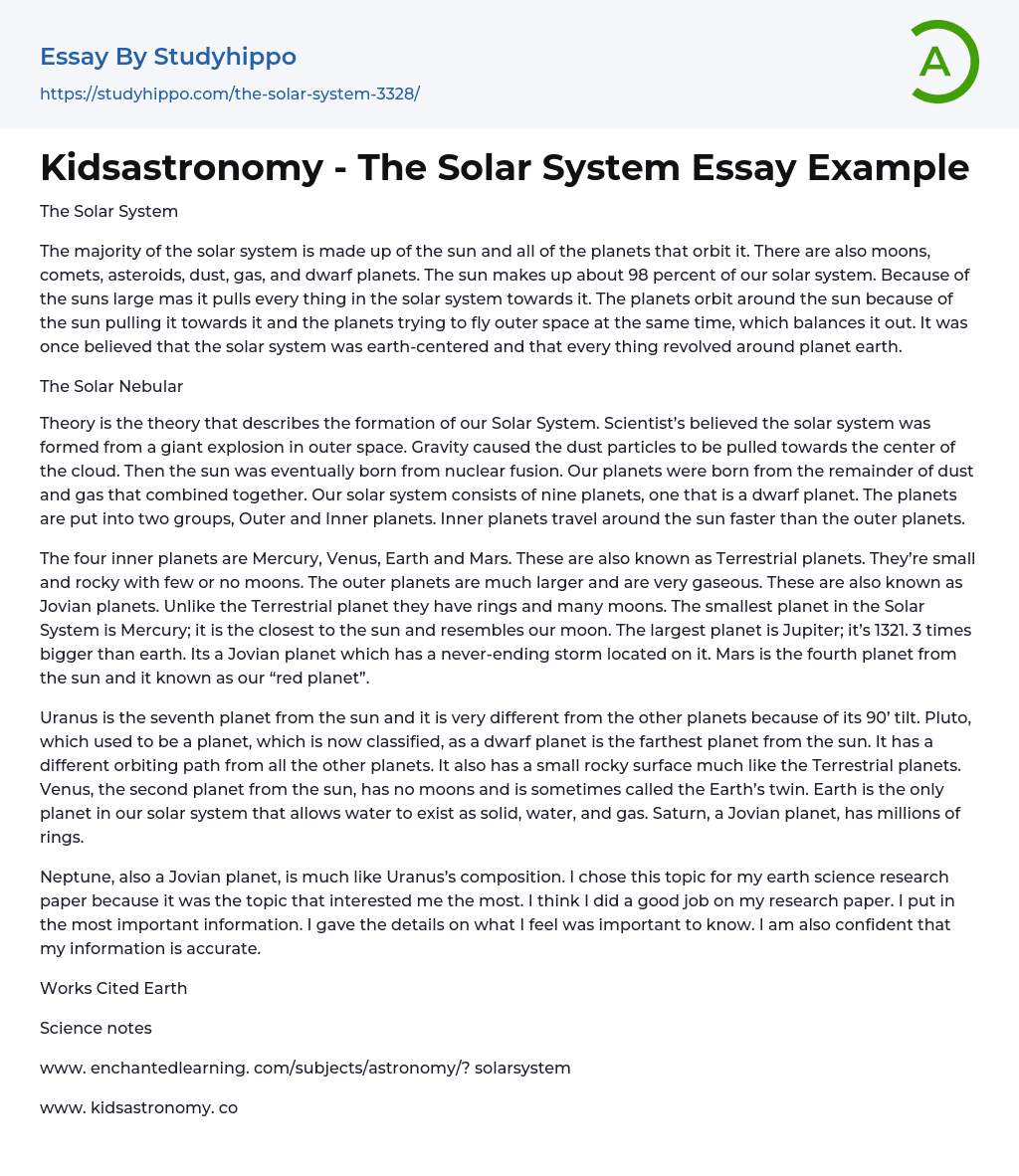The Solar System
The majority of the solar system is made up of the sun and all of the planets that orbit it. There are also moons, comets, asteroids, dust, gas, and dwarf planets. The sun makes up about 98 percent of our solar system. Because of the suns large mas it pulls every thing in the solar system towards it. The planets orbit around the sun because of the sun pulling it towards it and the planets trying to fly outer space at the same time, which balances it out. It was once believed that the solar system was earth-centered and that every thing revolved around planet earth.
The Solar Nebular
Theory is the theory that describes the formation of our Solar System. Scientist’s believed the solar system was formed from a giant explosion in outer space. Gravity cause
...d the dust particles to be pulled towards the center of the cloud. Then the sun was eventually born from nuclear fusion. Our planets were born from the remainder of dust and gas that combined together. Our solar system consists of nine planets, one that is a dwarf planet. The planets are put into two groups, Outer and Inner planets. Inner planets travel around the sun faster than the outer planets.
The four inner planets are Mercury, Venus, Earth and Mars. These are also known as Terrestrial planets. They’re small and rocky with few or no moons. The outer planets are much larger and are very gaseous. These are also known as Jovian planets. Unlike the Terrestrial planet they have rings and many moons. The smallest planet in the Solar System is Mercury; it is the closest to the su
and resembles our moon. The largest planet is Jupiter; it’s 1321. 3 times bigger than earth. Its a Jovian planet which has a never-ending storm located on it. Mars is the fourth planet from the sun and it known as our “red planet”.
Uranus is the seventh planet from the sun and it is very different from the other planets because of its 90’ tilt. Pluto, which used to be a planet, which is now classified, as a dwarf planet is the farthest planet from the sun. It has a different orbiting path from all the other planets. It also has a small rocky surface much like the Terrestrial planets. Venus, the second planet from the sun, has no moons and is sometimes called the Earth’s twin. Earth is the only planet in our solar system that allows water to exist as solid, water, and gas. Saturn, a Jovian planet, has millions of rings.
Neptune, also a Jovian planet, is much like Uranus’s composition. I chose this topic for my earth science research paper because it was the topic that interested me the most. I think I did a good job on my research paper. I put in the most important information. I gave the details on what I feel was important to know. I am also confident that my information is accurate.
Works Cited Earth
Science notes
www. enchantedlearning. com/subjects/astronomy/? solarsystem
www. kidsastronomy. com/solar_system. htm www. solarviews. com/eng/solarsys. html
- Energy essays
- Density essays
- Thermodynamics essays
- Motion essays
- Atom essays
- Sound essays
- Electricity essays
- Nuclear Power essays
- Temperature essays
- Physiology essays
- Light essays
- Force essays
- Heat essays
- Speed essays
- Big Bang Theory essays
- Energy Development essays
- The elements essays
- Voltage essays
- Solar Energy essays
- Nuclear Energy essays
- Alternative Energy essays
- Melting essays
- Nuclear Family essays
- Agriculture essays
- Albert einstein essays
- Animals essays
- Archaeology essays
- Bear essays
- Biology essays
- Birds essays
- Butterfly essays
- Cat essays
- Charles Darwin essays
- Chemistry essays
- Dinosaur essays
- Discovery essays
- Dolphin essays
- Elephant essays
- Eli Whitney essays
- Environmental Science essays
- Evolution essays
- Fish essays
- Genetics essays
- Horse essays
- Human Evolution essays
- Isaac Newton essays
- Journal essays
- Linguistics essays
- Lion essays
- Logic essays




